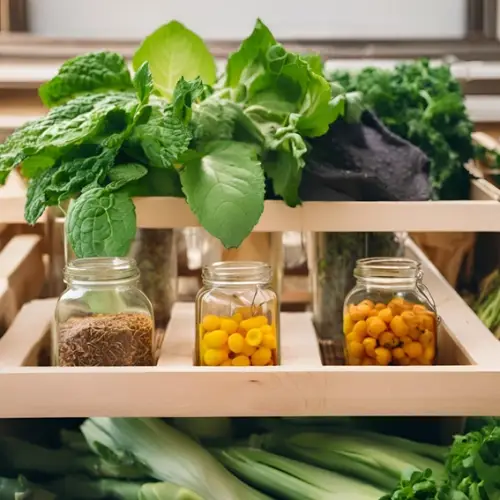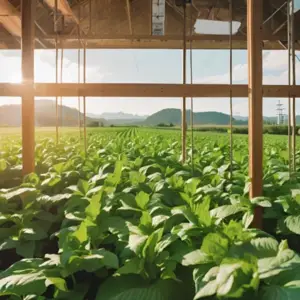Green Growth: Exploring Bioeconomy and Organic Resources

Knowledge
- Comprehensive understanding of bioeconomy principles and practices, including the role of renewable biological resources.
- Advanced knowledge of the role of organic resources in sustainable development.
- Critical understanding of theories and principles related to bioeconomy and resource management.
Skills
- Ability to analyze and develop strategies for integrating organic resources into the bioeconomy.
- Competence in evaluating the economic and environmental benefits of bio-based products and processes.
- Proficiency in using tools and methods for assessing the sustainability of bioeconomy initiatives.
Responsibility & Autonomy
- Capability to manage complex projects related to bioeconomy and sustainability, making strategic decisions.
- Responsibility for promoting and implementing sustainable bio-based practices within organizations and communities.
- Commitment to continuous professional development and the education of team members in bioeconomy sustainability.
The bioeconomy represents a transformative approach to sustainability, focusing on the use of renewable biological resources to produce food, materials, and energy. With the pressing issues of climate change and resource depletion, transitioning to a bio-based economy is more crucial than ever. In this WebQuest, you will embark on an exciting journey to explore the principles of the bioeconomy and discover the critical role that organic resources play in building a sustainable future.
Imagine being part of a pioneering team tasked with integrating organic resources into innovative bio-based products and processes. Your mission is to analyse a specific organic resource, develop a strategy for its integration, and evaluate the economic and environmental benefits of your proposed initiative. This project will not only help you understand the theoretical aspects of bioeconomy but also provide hands-on experience in applying these concepts in real-world scenarios.
Organic resources such as agricultural residues, food waste, and biomass are vital for the bioeconomy. These resources can be converted into valuable products, reducing waste and environmental impact while promoting economic growth. By leveraging organic resources, we can develop innovative solutions that contribute to a greener and more sustainable future.
Throughout this WebQuest, you will engage in a practical and immersive project that will deepen your understanding of bio-based products and processes. You will analyse current practices, propose strategies for improvement, and explore the feasibility of integrating organic resources into the bioeconomy. This journey will equip you with the knowledge and skills needed to contribute to a more sustainable and resource-efficient future.

- Conduct an analysis of a specific organic resource: select an organic resource (e.g., agricultural residues, food waste, biomass) and perform a comprehensive analysis to assess its availability, current uses, and potential applications in the bioeconomy.
- Develop a bioeconomy strategy: based on your analysis, develop a detailed strategy for integrating the selected organic resource into a bio-based product or process. Consider factors such as feasibility, scalability, and sustainability.
- Evaluate economic and environmental benefits: assess the economic and environmental benefits of the proposed bioeconomy initiative. This includes calculating potential cost savings, reductions in carbon emissions, and other sustainability metrics.
- Compile a detailed report: document your entire process and findings in a comprehensive report. the report should include:
- An overview of the selected organic resource and its current uses.
- The proposed strategy for integrating the organic resource into the bioeconomy.
- An evaluation of the economic and environmental benefits of the proposed initiative.
- Prepare a Multimedia Presentation: Create a multimedia presentation to share your findings and proposals with the class. The presentation should visually summarise your analysis, strategy, and evaluation results using charts, graphs, images, and videos.
- Group formation and initial brainstorming: Divide the class into groups of 3-4 students. Each group discusses and selects an organic resource to explore. Initial discussion and brainstorming to generate ideas on potential resources to analyse.
- Selection of organic resources and creation of a group Wiki: Each group selects an organic resource (agricultural residues, food waste, biomass,...) and creates a Wiki to document the process and findings.
- Research and infographic creation: Conduct preliminary research on bioeconomy and the selected resource. Create infographics, with a tool such as Canva, to visualise key information regarding the chosen resource. The students have to research on the web, create the infographics, and publish all the collected and created material on the Wiki.
- Analysis of resource: Use online tools, like Miro to analyse the resource and map the related bioeconomic system. Identify key actors, material flows, and opportunities; and publish the results on the Wiki.
- Stakeholder engagement and podcast creation: engage key stakeholders through interviews and create a podcast (with Audacity) to share their perspectives. The students have to plan and conduct interviews, record and publish the podcast on the Wiki.
- Development of bioeconomy strategy: Based on the findings from the analysis and stakeholder feedback, develop a detailed strategy for integrating the organic resource into a bio-based product or process.
- Economic and environmental evaluation and explanatory video creation: Evaluate economic and environmental benefits using free tools, like Carbon Footprint Calculator, and create explanatory videos to present the findings.
- Report and presentation preparation: Organise an online event, using online platforms like Zoom , Google Meet or similar, to present your Wikis to the class.
- Provide feedback: Each group should provide constructive feedback regarding other groups’ work.
- Bioeconomy knowledge center: A comprehensive resource for information on bioeconomy principles, practices, and policies. Provides access to a wealth of articles, reports, and data.
- How to Create a Wiki - Collecting and Sharing Knowledge at Work
- How to Make a Free Wiki: 10 Steps (with Pictures)
- Canva: An online graphic design tool used for creating infographics to visualise key bioeconomy data clearly and attractively.
- Miro: A collaborative online platform for creating conceptual maps and diagrams, used to map the bioeconomic system and identify key actors and material flows.
- Audacity: A free audio recording and editing software for recording and editing stakeholder interviews, creating podcasts to share their perspectives.
- Carbon Footprint Calculator: An online tool for calculating the carbon footprint of activities and processes, used to assess the environmental benefits of the bioeconomy initiative.
- Zoom: A video conferencing platform for organising and managing virtual meetings, used for the final presentation event to share projects with the class and stakeholders.
- Google Meet: A video conferencing platform for conducting online meetings, providing an alternative for the final presentation event to ensure smooth participation.
- How can students make their own podcast?: This video shares strategies for creating podcasts with students, discussing the importance of planning, recording, and editing. It emphasises how podcasting can enhance students' communication skills and engage them in creative projects.
- Teaching students how to create their own podcasts | webinar: This webinar provides a comprehensive guide on how to teach students to create their own podcasts. it covers everything from the initial concept to the final production, making it a great resource for educators looking to incorporate podcasting into their curriculum.
The bioeconomy offers a promising pathway to sustainability by leveraging renewable biological resources to create valuable products and processes. Throughout this WebQuest, you have explored the principles of the bioeconomy, analysed organic resources, and developed strategies for their integration into bio-based initiatives.
By conducting an analysis of an organic resource, you have gained insights into its potential applications and benefits. Developing a bioeconomy strategy has shown you the importance of innovation and sustainability in creating a circular economy. The economic and environmental evaluations have provided a clear picture of how these initiatives can contribute to a more sustainable future.
Reflect on the valuable knowledge and skills you have acquired during this project. These tools empower you to make informed decisions and implement sustainable practices in your future careers and daily lives. Your contributions to the bioeconomy and the utilisation of organic resources can lead to significant positive changes for the environment and society. Remember, each step you take towards sustainability is a step towards a brighter, greener future.
Continue to explore, innovate, and advocate for sustainable bio-based solutions. Your efforts are paving the way for a more resilient and sustainable world, benefiting not only our generation but also those to come. Together, we can create a legacy of environmental responsibility and sustainable progress.
Novamont's Bio-based Products
Novamont is a leading company in the bioeconomy sector known for its innovative bio-based products made from renewable resources. Their flagship product, Mater-Bi, is a biodegradable and compostable bioplastic derived from agricultural materials. Novamont's approach illustrates how organic resources can be effectively integrated into bioeconomy initiatives to create sustainable alternatives to traditional plastics, reduce environmental impact, and promote circular economy practices.
